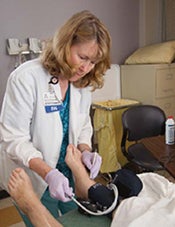Ankle-Brachial Index ABI
Arteries exist throughout our bodies and, when they become blocked, they too can cause life-threatening problems. A simple, painless test involving your arm and your ankle can help detect these blockages and help your doctor provide the treatment you need.
Peripheral Artery Disease & the Ankle-Brachial Index
Peripheral Artery Disease (PAD) is a serious health condition characterized by narrowed or blocked arteries in the legs and/or arms caused by a buildup of fatty deposits (plaque). PAD can lead to kidney disease, poor circulation and even critical limb ischemia, gangrene, and abdominal aortic aneurysms.
People who have PAD also have a risk of suffering a heart attack or stroke that is five times greater than people who do not have the disease. The reverse is also true. If you have a known blockage in an artery around the heart, you are more likely to have blocked arteries in other parts of your body.
What can your arms an ankles tell you about your arteries?
An ankle-brachial index (ABI) exam can help your physician determine if you have PAD. During an ABI physicians measure the blood pressure in the arm, measure the blood pressure in the ankle, do some simple division and calculate the likelihood of blockage.
How Obstructions are Measured Using the ABI
An ABI of 0.90 to 1 means it is likely no blockage exists. Other results indicate varying degrees of blockage and the need for additional tests to determine where the blockage is and how the patient’s condition should be treated (surgically, medication, lifestyle changes, watchful waiting).
-
0.71-0.90 – Mild obstruction
-
0.41-070 – Moderate obstruction
An ABI of around 0.50 tells your doctor that your blood pressure in your leg is half that of the blood pressure in your arm, which indicates a potentially serious problem and further tests are possibly needed.
Symptoms & Risk Factors Associated with PAD
Pain, or claudication, is the predominant symptom of peripheral artery disease. About 30 percent of PAD patients have the classic symptom, which is calf pain that subsides when the person stops exercising the leg. But about 50 percent of PAD patients have other symptoms — such as buttocks pain, pelvic pain or burning or numbness in the feet.

Risk factors for PAD include:
- Diabetes
- Smoking
- High blood pressure
- Age 50+
- Known kidney problems
- High cholesterol
- Overweight
- CAD
One in every 20 Americans over the age of 50 has peripheral arterial disease, according to the American Heart Association.
Timely detection of the disease, starting with a simple brachial-index exam, can help you stay mobile and reduce your risk of heart attack, stroke or leg amputation. Ask your doctor to perform an ankle-brachial index exam.